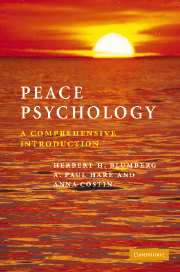Book contents
- Frontmatter
- Contents
- Preface
- Acknowledgements
- The scope, structure and content of this book
- Part I Introduction
- Part II Interdisciplinary practice
- 2 Government policy and international relations
- 3 Education
- 4 The feminist approach
- 5 Philosophy, ethics and religion
- Part III Primary psychological topics
- Part IV Core topics in peace and environmental studies
- Part V Terrorism
- References
- Index
4 - The feminist approach
Published online by Cambridge University Press: 05 June 2012
- Frontmatter
- Contents
- Preface
- Acknowledgements
- The scope, structure and content of this book
- Part I Introduction
- Part II Interdisciplinary practice
- 2 Government policy and international relations
- 3 Education
- 4 The feminist approach
- 5 Philosophy, ethics and religion
- Part III Primary psychological topics
- Part IV Core topics in peace and environmental studies
- Part V Terrorism
- References
- Index
Summary
This chapter looks at both feminist methods of conceptualizing and initializing peace, and the effects of conflict on women and girls. The feminist approach is distinct from other conceptual approaches in its philosophy and analysis and is one that has often been overlooked or marginalized in peace studies.
Understanding the feminist approach to peace psychology
Feminist analysis is a system of thought that analyses the world through the experiences of women as subjects. McKay (1995) states that although interdisciplinary feminist analyses of conflict, violence and peace have produced a substantial body of research, feminist perspectives in peace psychology are only just starting to be discussed. The greater focus of peace psychology has been on the international field and security studies, where women psychologists' input has been limited. Obviously, if women do not publish their studies as much as men, they will be less visible. This is further compounded if they choose not to involve themselves in international activism. Feminist scholars in other disciplines, such as international relations, have also discussed the marginal involvement of women (e.g. Tinckner, 1992).
McKay (1995) argues that there is a need for gendering in peace psychology, as it has disregarded gender differences and needs to balance its patriarchal assumptions by including the perspectives of women. McKay and Mazurana (2001) state that gendered thinking highlights substantial differences between female and male perspectives.
- Type
- Chapter
- Information
- Peace PsychologyA Comprehensive Introduction, pp. 37 - 45Publisher: Cambridge University PressPrint publication year: 2006



